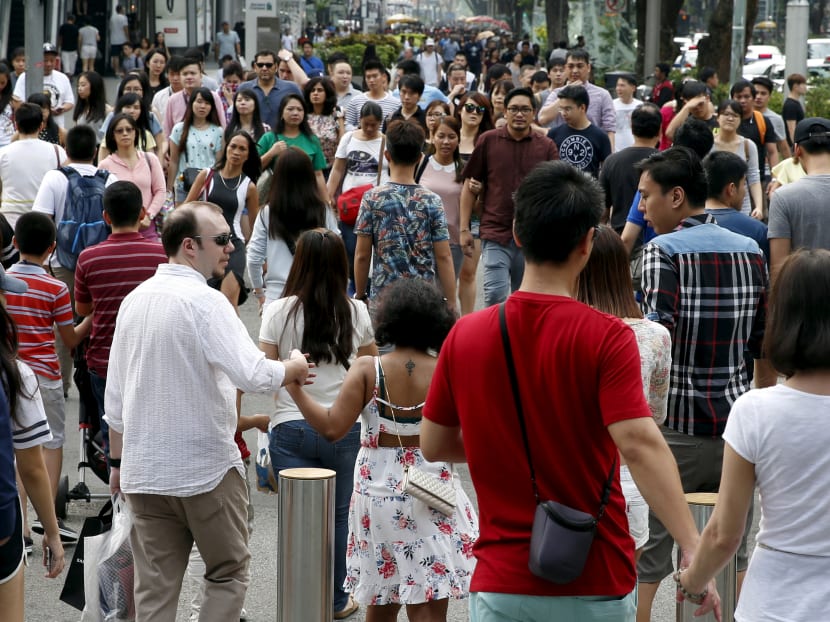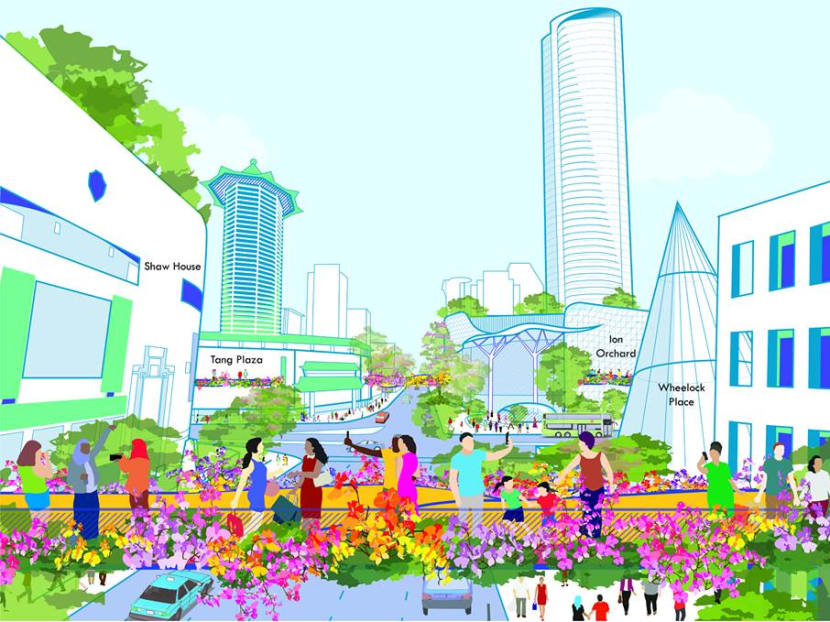Will plans to rejuvenate Orchard Road work?
The Government’s recently announced plans to transform Orchard Road into a green “lifestyle destination” include offering different themed lifestyle experiences and developing a highly walkable green corridor along Singapore’s most famous thoroughfare. Will they work and what are the challenges involved?

The authorities’ new plans for the shopping belt focused more on the use of outdoor spaces and infrastructure enhancements.
Yet indoor spaces and service quality (of retailers for example) also play a very important role in helping consumers pick where to go, say the authors.
The Government’s recently announced plans to transform Orchard Road into a green “lifestyle destination” include offering different themed lifestyle experiences and developing a highly walkable green corridor along Singapore’s most famous thoroughfare.
Will they work and what are the challenges involved?
Here are three positive things about the new plans.
1. Greater variety of offerings
Visitors usually associate Orchard Road with shopping only, but that could well change if the new plans work.
First, more family-friendly and green attractions will be built around Dhoby Ghaut.
Second, consumers will have easy access to Singapore’s home-grown brands and local designs at the new Design Orchard at Somerset, while more spaces for arts and cultural purposes will be set up around the Tanglin area.
The newly available options will draw visitors who want lifestyle experiences rather than shopping for established brands.
2. Better visitor experience
The clearer positioning of each sub-precinct, higher walkability and better landscaping along Orchard road will provide better visitor experience.
The new plans will see Orchard Road developed into four sub-precincts with different themes as follows:
-
Tanglin: Arts and cultural
-
Orchard: Shopping and entertainment
-
Somerset: Youth and designer
-
Dhoby Ghaut: Family-friendly and garden
Each sub-precinct will build on its own unique identity and grow it. Together they will form a lifestyle destination offering various experiences for all to enjoy. With clearer and stronger identity, each sub-precinct can better focus its resources and efforts on meeting specific needs of visitors.
The new plans will build infrastructure to better connect every part along the road. The higher walkability of Orchard Road gives visitors greater convenience and improves their experience.
A green urban corridor comprising curated displays of flowering trees and shrubs will be introduced.
The landscaping will showcase the unique character of each sub-precinct, and add colour and vibrancy to Orchard Road. This will enhance the visual pleasure and experience of visitors.
3. Closer to market trends
Increasing the space and frequency for pop-up stores, events and activities along the pedestrian spaces on Orchard Road will help create a buzz and draw visitors.
The shorter terms of lease for pop-ups and events also allow retailers and event organisers to be more responsive to the market needs.

An artist's impression of a new vantage point at the junction of Orchard Road and Paterson Road. Photo: Singapore Tourism Board / Facebook
A new vantage point on a new elevated link-bridge at the Orchard/Paterson Road Junction will draw tourists who love posting Instagram-worthy pictures of their travels on social media.
If pictures of Orchard Road go viral online, many more visitors will be drawn to the area.
While the rejuvenation plans are laudable, we can expect some challenges in implementation.
It is also quite possible that some of the plans will not achieve their stated goals.
First, the different themed experiences in the four sub-precincts may be hard to implement in a short period of time.
For instance, how do you get existing businesses that do not match the theme of the sub-precinct to move out?
Even if they do, malls and landlords may not bother to match the theme of the sub-precinct when renting out the spaces and conducting marketing activities.
Visitors will be confused if the sub-precinct’s theme does not match what the malls and retailers are offering.
Implementing the themed experiences will therefore require taking care of the interests of the different stakeholders.
This process will take time and effort.
Second, visitors are becoming more well-travelled and are constantly demanding newer and better things. They will compare Orchard Road with the attractions of other cities.
The authorities’ new plans for the shopping belt focused more on the use of outdoor spaces and infrastructure enhancements.
Yet indoor spaces and service quality (of retailers for example) also play a very important role in helping consumers pick where to go.
Today, malls in Singapore mostly consist of numerous independent retailers. The management of the malls usually focuses more on bringing high quantity of foot traffic to the malls, whereas retailers need foot traffic of high quality — visitors who are willing to spend.
Visitors look for high service standards in both public spaces and retail stores which are managed by the malls and individual retailers respectively.
Going forward, one should look at how to facilitate better collaboration among malls and retailers to improve the use of indoor spaces and service quality on Orchard Road.
Third, with more pop-up events, pedestrian pavements along Orchard road may become even more crowded.
Converting a section of Orchard Road to be a car-free zone or widening the pedestrian pavements may help divert the flow of visitors making the experience more pleasant.
Competition in the tourism industry is fierce, and the retail industry is fast-evolving.
While Singapore’s tourism performance is strong, with international visitor arrivals growing at a compound annual rate of 6.2 per cent from 2008 to 2017, the average length of stay and tourism receipts per capita expenditure have declined in the past few years.
This means that more tourists visited Singapore, but they spent less time and less money here.
At the same time, outbound departures of Singapore residents grew rapidly in the last decade. This means that residents here are also spending less time in Singapore.
On the retail front, e-commerce now accounts for about 5 to 7 per cent of total retail sales in Singapore and is expected to grow up to 10 per cent in the coming years.
The rise of e-commerce presents challenges for brick and mortar stores in Singapore.
Seen in this context, the rejuvenation of Orchard Road as an attractive lifestyle destination is timely. The new plans also contain some exciting ideas to attract visitors.
But the biggest challenge is how to manage the stakeholders who have different interests and get them on board in implementing these plans.
ABOUT THE AUTHOR:
Dr Wong King Yin is a lecturer from the Marketing and International Business Division of Nanyang Business School at Nanyang Technological University. Her research interests include service technology and tourism marketing, and she has prior working experience in marketing and tourism.






